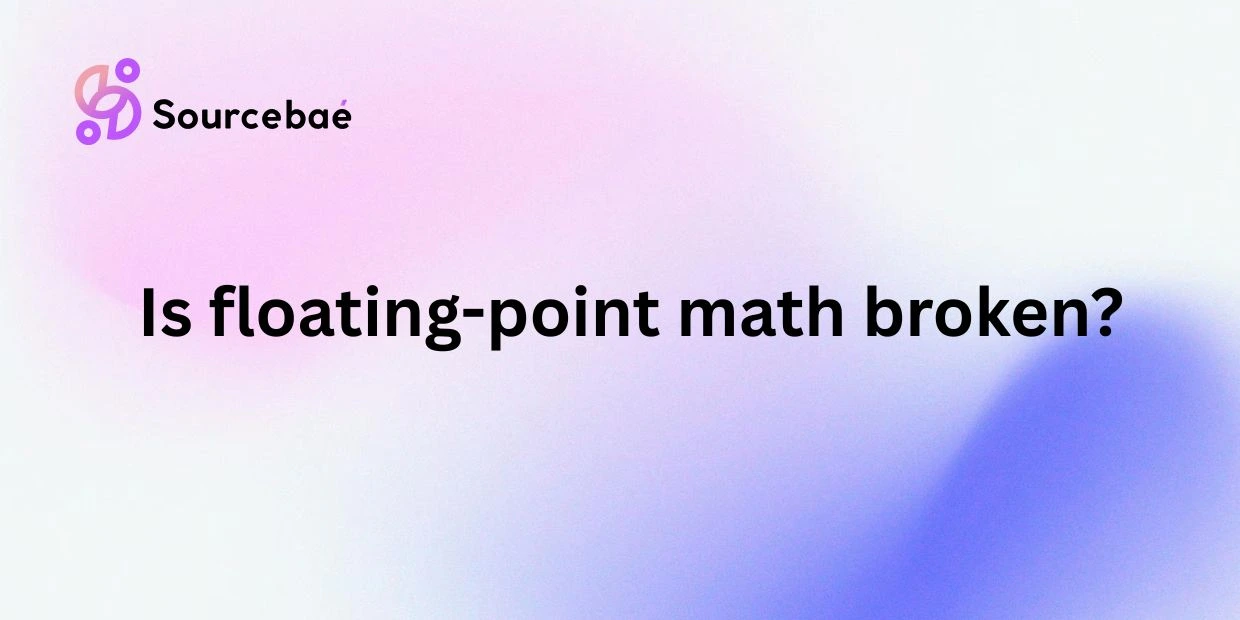Floating-point math is one of those technical topics that programmers debate fiercely. Some see floating-point arithmetic as an unreliable source of errors, while others believe it’s an essential tool that’s unfairly criticized. In this article, we’ll dive deep into floating-point math, exploring exactly what it is, why some people think it’s broken, and whether or not it’s genuinely flawed. We’ll also outline practical strategies for mitigating common floating-point math issues, allowing you to write cleaner, more reliable code. So, let’s get started and unpack the mystery surrounding floating-point math.
What Is Floating-Point Math?
To first understand the controversy, we need clarity on exactly what floating-point math is.
Definition and Representation in Computer Systems
Floating-point math is a method computers use to represent real numbers (numbers with decimals) in a compact binary form. Because computers internally handle everything as binary digits—0s and 1s—representing numbers with decimal points presents a unique challenge.
To handle fractional numbers, computers follow the IEEE-754 standard, a widely accepted framework defining how floats and double-precision numbers are stored in memory. This standard specifies a representation using three components: a sign bit (positive/negative), an exponent, and a mantissa (or fractional part). Together, these components allow computers to represent a broad range of decimal values with reasonable accuracy.
Floating-Point vs. Integer Math: Key Differences
Integer math, in contrast, deals exclusively with whole numbers—no fractions or decimals. Integer operations are straightforward, exact, and fast. Floating-point math is more versatile but inherently more complex and sometimes less precise due to inherent rounding and precision limitations.
Within programming environments, integers occupy a distinct memory region separate from floating-point numbers. This structural separation further emphasizes their differences. Integer calculations are guaranteed exact; floating-point numbers, however, approximate decimal values, causing precision issues.
Common Applications for Floating-Point Math in Programming
Almost every modern application uses floating-point math to some degree. Common scenarios include:
- Scientific computing and simulations
- Graphics rendering, gaming engines, and animation software
- Financial calculations, modeling investment returns, interest rates
- Statistical analysis, artificial intelligence, and machine learning algorithms
- Engineering calculations, measurements, and data visualization
Given floating-point math’s widespread applications, its perceived reliability issues are significant enough to merit deep scrutiny.
Why Do People Think Floating-Point Math Is Broken?
Floating-point math attracts controversy primarily due to issues with precision, equality testing, and learner confusion about its behavior.
Issues with Precision and Rounding Errors
Floating-point numbers represent decimals using binary approximations, leading to subtle rounding errors. Simple decimal arithmetic like 0.1 + 0.2 famously does not equal exactly 0.3 in floating-point representation—this mathematically incorrect result perplexes many beginners.
In standard programming scenarios, these tiny rounding differences might appear harmless but accumulate later, producing larger, unpredictable inaccuracies. This behavior makes floating-point arithmetic notoriously tricky, often leaving programmers questioning its reliability.
Problems with Comparisons and Equality Testing
Testing floating-point numbers for equality is problematic due to these rounding and precision errors. Code that appears logical (if sum == 0.3) often returns false unexpectedly, creating significant headaches for debugging code that relies on direct comparisons.
Instead, programmers must rely on comparisons within an acceptable tolerance range (such as abs(a - b) < epsilon). However, many programmers new to floating-point arithmetic misplace trust in the default equality operator (==), exacerbating their frustration and confusion around the topic.
Difficulty in Predicting Results Accurately
When working with floating-point math, precise prediction of exact numeric results isn’t always possible. Result deviation from expected outcomes often leads developers to mistakenly blame “broken” floating-point arithmetic. Consequently, floating-point math becomes misunderstood: fundamentally correct, yet unclear and unintuitive for beginners.
Real-World Examples of Floating-Point Math Issues
Floating-point precision issues have created serious problems in various systems and applications:
- Financial software rounding errors resulting in lost revenue or incorrect totals.
- NASA experienced challenges with floating-point precision when determining spacecraft trajectories.
- Gaming engines experiencing erratic physics behaviors due to accumulated precision errors.
These practical problems reinforce people’s perception that floating-point math is inherently faulty.
Is Floating-Point Math Actually Broken?
Despite floating-point math’s subtle problems and oddities, it isn’t truly broken—at least not fundamentally. Understanding its limitations reveals the genuine power this representation brings to software development.
Arguments Supporting Floating-Point Math
Floating-point math aligns well with well-defined IEEE standards, allowing portability, compatibility, and predictable behavior between software programs and hardware. Without floating-point capabilities, representing a broad range of real numbers quickly and efficiently would be impractical.
Furthermore, the math behind floating points is meticulously designed. The complexity and unintuitive behaviors are inherent trade-offs for representing an almost infinite range of numbers within finite memory constraints.
Successful Implementations in Various Applications
Numerous successful applications leverage floating-point math extensively with remarkable success:
- Modern 3D video games, physics engines (like Unity or Unreal Engine), and graphics rendering technologies.
- Aerospace trajectory calculations, GPS positioning, and precision geographical mapping technologies.
- Advanced machine learning and artificial intelligence frameworks like TensorFlow and PyTorch.
- Robust financial analysis tools and trading algorithms producing precision and high volume risk computations.
These everyday applications validate that floating-point arithmetic, while sometimes quirky, is effective in demanding, complex computational scenarios.
Practical Strategies to Mitigate Floating-Point Math Issues
Programmers can effectively navigate floating-point math concerns by adopting proven practices:
- Use proper tolerance testing:
Instead of equality operators, test floating-point numbers within an acceptable epsilon:if abs(value - expected) < 1e-9: print("They’re essentially equal!") - Leverage Decimal libraries:
For business-critical calculations requiring maximum precision (like financial data), many languages provide specialized “decimal libraries” that handle numeric precision more predictably. - Utilize arbitrary precision numerics:
For more extreme precision, like cryptography or high-end scientific research, arbitrary precision numeric systems grant virtually unlimited accuracy.
- Use debugging and validation tools regularly:
Including robust floating-point assertions, boundary checks, and systematic unit testing reduces the likelihood of unnoticed inaccuracies.
FAQs About Floating-Point Math
What are the main challenges with floating-point math?
The primary challenges are inherently limited precision, unexpected rounding errors, and difficulty conducting equality comparisons accurately.
How can I avoid errors when using floating-point math?
Always use comparison tolerances, leverage specialized libraries if precision is critical, validate your algorithms extensively, and thoroughly test floating-point code to detect inconsistencies early.
Are there alternative solutions to floating-point math?
Yes, languages often offer alternatives like fixed-point arithmetic, Rational number libraries, and arbitrary precision numeric representations (such as Python’s Decimal or Java’s BigDecimal).
Which programming languages or libraries handle floating-point math better?
Languages with stronger computational libraries and rich ecosystems often handle floating points exceptionally well. Python, Java, C++, MATLAB, and R include powerful numeric libraries designed explicitly for floating-point robustness.
How can I test and debug floating-point math effectively?
Implement precise unit tests, logging, and code assertions. Additionally, employ debugging tools capable of inspecting floating-point representations and detecting subtle numeric anomalies.
Conclusion
Floating-point math, while occasionally frustrating, is far from fundamentally broken. Its quirks stem from inherent trade-offs associated with approximating real numbers within predictable binary constraints. Although this complexity may initially confuse programmers, deeper understanding allows correct, predictable, and manageable utilization.
The debate around floating-point math highlights its complexities, encouraging developers to respect limitations while maximizing potential benefits through careful, informed decisions. By applying the outlined strategies and clearly understanding floating-point behavior, programmers can confidently harness its strengths while minimizing challenges and misunderstandings surrounding this misunderstood but essential mathematical framework.






